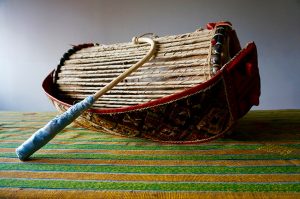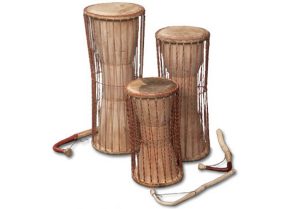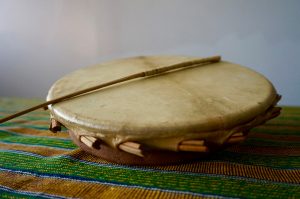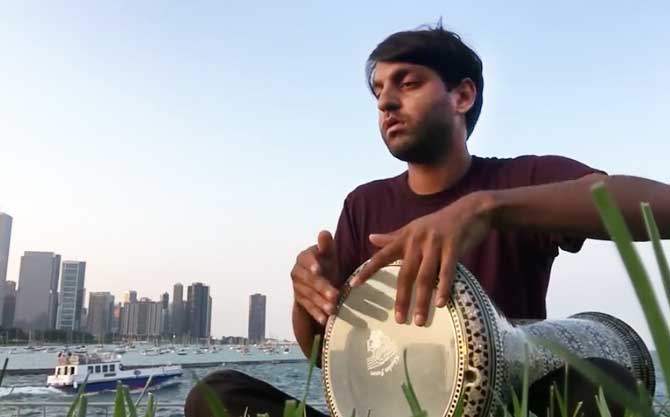
Neel Agrawal, the LA Law Library’s head of research and reference Ralph Stahlberg and UCLA’s Dr. Jesse Ruskin alongside an exhibit that was part of an April presentation on African drum law. (Photo: Courtesy the LA Law Library)
Native drums have long been associated with Africa’s cultural roots, integral to the daily life and rituals of many communities. Their repercussions have spread worldwide, providing the launchpad for a multitude of music styles from jazz to rock and roll, which influence is widely recognized. Less known is the disruptive effect of colonial drumming regulation as a means of controlling African society. Thanks to an ambitious research project by Los Angeles legal scholar and world music percussionist Neel Agrawal, we’re beginning to get the picture.
Agrawal, 33, is piecing together a puzzle that spans many African countries, documenting various aspects of drumming — much of it ceremonial — in the everyday life of communities. He is also cataloging the flip side: laws instituted by colonial governments to control how and when drums may be used.
As to the intent behind such laws, whether convenience — the equivalent of nuisance noise laws that prohibit loud music after hours — or oppression through control of activity that had a spiritual and societal role in the lives of indigenous peoples, Agrawal has yet to form an opinion.

The Dundun is a rope-tuned cylindrical drum with a rawhide skin.
“That’s the million dollar question,” says Agrawal, who says it’s too early in his research to speculate, though he has documented some similarities to restrictions on the African slave populations in pre-revolutionary America.
“One of the things that was done to pretty much control communities of black slaves was to take away their cultural fabric, their institutions, their traditions. It’s such a sensitive topic that we don’t want to draw any premature conclusions, but the suspicion exists that it’s part of colonial suppression.”
The regulations include things like having to pay a license fee to be allowed to play drums in Western Nigeria, to actual criminal liability in Ghana.
Ethnomusicology is the study of how music affects culture, a field of study at many universities. Agrawal, however, is fortunate to have proximity to one of the premiere departments on the planet, the UCLA Herb Alpert School of Music. “It’s got the largest collection of instruments, with about 800, from all over the world.”
Agrawal has been working with Dr. Jesse Ruskin, with whom he will today give a three-hour lecture on “African Drumming Laws: Colonial Governance of African Customs,” beginning at 3 p.m., in Dr. Dan Neuman’s PhD course in ethnomusicology at the UCLA Herb Alpert School of Music.
Harvard Hears the Beat
As a 2016 summer fellow at the Harvard Library Innovation Lab, Agrawal “studied their maps, their anthropology, I went through a lot of materials. So, the colonial government in Western Nigeria, how did the government work? What did it look like?” For Agrawal and his team, there are more questions than answers. To help sort it out he’s enlisted a network that includes professor Helen Rees, director of the World Music Center at UCLA.
Documentation of the drum laws is his passion. Working with a colleague, web developer Gaurav Bhatnagar, Agrawal put together an interactive map at AfricanDrummingLaws.org that lists regulations for 120 different native drums and music genres in Western Nigeria and throughout the continent.

The talking drum is hourglass-shaped and can be used to suggest a human voice. The pitch can be adjusted by tightening the strings.
For the Apala genre of music, there are 50 laws among 47 district councils. The website documents laws from 1956 to 1975, though Agrawal has found statutes dating from the early 1900s. With origins among the Yoruba people of Nigeria, the percussion-based style of Apala music came about in the late 1930s, when it was used to wake worshippers after fasting during the Islamic holy month of Ramadan.
In West African music, a popular rhythm instrument is the “talking drum,” which functions as a speech surrogate, imitating the tones and inflections of the Yoruba language. The pitch is controlled by applying pressure to the side ropes with the hand and wrist. Within the talking drum family, the Iya Ilu the ‘mother voice,'” says Agrawal.
There are 47 laws pertaining to the Iya Ilu, and 43 for the Dundun. Finding the drums on the list along the left-hand side of the site, you can hover over the names and see the pinpoints jump to life in the geographic regions where the instrument was used the map to the right. Alternatively, if you drag the cursor along the map, pop ups will inform as to which drums were used, and the nature of the laws.
A random hit on Owo, in the Ondo State of Western Nigeria, reveals 24 drums controlled by law. “It tells you how important the drums were, and the relevance to the local culture and the government,” Agrawal says. When I refer to the populace as “tribes” he corrects me. “I think it’s more like native populations. Can’t say if they’re tribal or not, but they had these rituals and cultural practices whereby drumming was very significant. I don’t know if it was communicative in every instance, but it was very important in terms of the cultural activities.
A Musical Upbringing
Music has been an important cultural activity for Agrawal growing up in Lansing, Michigan, where he initially took violin lessons, then gravitated toward drums, playing a conventional drum kit. Agrawal did both his undergraduate studies in political theory and got his J.D. from Michigan State University in East Lansing, after which he went to work at the national ACLU Criminal Law Reform Project in Santa Cruz, California, . While in Santa Cruz Agrawal was exposed to many different musical traditions from around the world.
From there, he enrolled in an Information Sciences program at the University of Washington. At the end of a very intensive one-year Masters program, which required a JD, Agrawal was certified in law librarianship, and recruited by the LA Law Library, joining in 2012 as global law librarian. The 125-year-old downtown Los Angeles institution is the second largest public law library in the US, after the Law Library of Congress.

The Sakara is a shallow drum with a circular body made of baked clay.
It was there he accidentally found his passion project. “I was looking up something for a law firm that had to do with Nigerian law. After reading the statutes I needed, I randomly flipped the pages and came across statutes regulating drum law.” His curiosity piqued, he began spending his free time investigating these little-known drum restrictions. Because the LA Law Library’s African collection is so vast, it was rather like searching for the proverbial needle in a haystack.
“Legal research is so specific, so if you’re not a law librarian you’re probably not getting exposed to it. Then you’re looking at African research, so outside of the LA Law Library, how many libraries in the world even have this type of research material? Maybe Seven? Eight?” The project has received funding from LexisNexis and the American Association of Law Libraries.
What has he learned about drum regulation? “There is a lot of fear behind it. In Ghana the drum laws of 2005 are verbatim the same as 1920 – equating drums with the firing of arms.” As an extension of his studies, Agrawal found some drumming laws in the Caribbean, and even one or two in the US. “I found a slave law in South Carolina from the 1840s that regulates drumming — criminalizes it. Georgia also has some drumming regulation. But nobody’s done academic research on drum laws. This is starting from the ground up.”
Drum Talk
So what are these talking drums saying? “Not all drums ‘talk,’ or convey an exact message, but within customary laws, say, for a funeral, a certain drum would be played at a certain time. Drumming is so important that they have spaces for different types of drumming, and rules — there’s a hierarchy of drummers and customary law that comes up from these communities because drums are held in such high regard. Then you’ve got the colonial laws coming in. So it’s really a comparative legal approach between the customary laws and the colonial laws.”
Some of the drums actually speak their own languages; the Atumpan “talking drum” of Ghana is one of many that actually convey messages, or sentiments. “It’s what’s called a speech surrogate drum. That’s just one example of how deep some of these traditions are. These are ethnic groups who have organically created their own traditions over time.”
The Yoruba people of Western Nigeria have perpetrated deep percussion influence. The Yoruban music spread, to Cuba, Brazil, and to America — anything to do with jazz. Yoruba music is deep, and it’s not just about the notes. Yes, it’s fascinating musically, but it’s also about the culture around it. Colonialism, the repression… and not just music, but dancing…”
Many of the communities have what are called “customary laws.” “In certain of those customs drumming is considered important – essential, I should say – fulfilling a variety of functions in daily life. I have legal customary law text from the LA Law Library that describes some of the functions of the drummers. Then you have the colonial laws, the statutes, of which I found more than 100, that seem to come at it from the power structure point of view, suppressing the drumming in these communities.”
When Agrawal isn’t working on academic research he’s often drumming, practicing for his many live performances, which span world styles from Flamenco to tabla. “I view all this stuff first and foremost as a drummer, and I think, what if these laws existed today? And regulated when or how I could drum? Would be a different person as a result of it?” These are questions that no amount of study can answer, but on which an extended dialogue can perhaps shed some light, contributing to a more just and tolerant world.



Comments are closed.